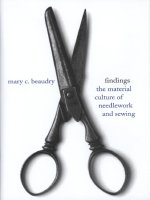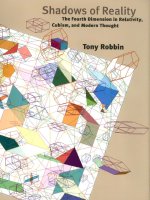yale university press shadows of reality the fourth dimension in relativity cubism and modern thought mar 2006
Bạn đang xem bản rút gọn của tài liệu. Xem và tải ngay bản đầy đủ của tài liệu tại đây (1.79 MB, 152 trang )
Shadows of Reality
Shadows
of
Reality
The Fourth Dimension in
Relativity, Cubism, and
Modern Thought
Tony Robbin
YALE UNIVERSITY PRESS NEW HAVEN & LONDON
Copyright ∫ 2006 by Tony Robbin.
All rights reserved.
This book may not be reproduced, in whole or in part,
including illustrations, in any form (beyond that
copying permitted by Sections 107 and 108 of the U.S.
Copyright Law and except by reviewers for the public
press), without written permission from the publishers.
Designed by James J. Johnson and set in
Aster Roman types by Keystone Typesetting, Inc.
Printed in the United States of America.
Library of Congress Cataloging-in-Publication Data
Robbin, Tony.
Shadows of reality : the fourth dimension in
relativity, cubism, and modern thought / Tony Robbin.
p. cm.
Includes bibliographical references and index.
ISBN
-13: 978-0-300-11039-5 (alk. paper)
ISBN
-10: 0-300-11039-1 (alk. paper)
1. Geometric quantization. 2. Fourth dimension.
3. Art—Mathematics. 4. Geometry in art. 5. Hyperspace.
I. Title.
QC
174.17.
G
46
R
63 2006
530.11—dc22
2005022806
A catalogue record for this book is available from the
British Library.
The paper in this book meets the guidelines for
permanence and durability of the Committee on
Production Guidelines for Book Longevity of the
Council on Library Resources.
10987654321
To Linda Henderson and Tom
Banchoff, who climbed up first
and set the rope
I have felt and given evidence of the practical
utility of handling space of four dimensions, as if
it were conceivable apace. Moreover, it should be
borne in mind that every perspective represen-
tation of figured space of four dimensions is a
figure in real space, and that the properties of
figures admit of being studied to a great extent,
if not completely, in their perspective
representations.
—J
AMES
J
OSEPH
S
YLVESTER
, 30 December 1869
Contents
Preface ix
Acknowledgments xiii
Part One.
Past Uses of the
Projective Model
Chapter 1. The Origins of Four-Dimensional
Geometry 3
Chapter 2. Fantasies of Four-Dimensional
Space 19
Chapter 3. The Fourth Dimension in
Painting 28
Chapter 4. The Truth 41
Entr’acte
Chapter 5. A Very Short Course in Projective
Geometry 53
Part Two.
Present Uses of the
Projective Model
Chapter 6. Patterns, Crystals, and
Projections 61
Chapter 7. Twistors and Projections 72
Chapter 8. Entanglement, Quantum Geometry,
and Projective Reality 83
Chapter 9. Category Theory, Higher-Dimensional
Algebra, and the Dimension Ladder 93
Chapter 10. The Computer Revolution in Four-
Dimensional Geometry 105
Chapter 11. Conclusion: Art, Math, and Technical
Drawing 114
Appendix 119
Notes 121
Bibliography 125
Index 129
Illustrations follow page 58
Preface
We walk in the here and now, but is there a space
beyond, a space that impinges on our own infi-
nite space, or more dramatically, a space wholly
applied to or inserted into our space? Perhaps
we remember being in the space of the womb,
and then we remember the cold infinity of space
that suddenly existed after our birth, and those
memories foster our belief that such a space
beyond space is possible. Mathematics can de-
fine and conquer the extra space and make four-
dimensional geometry into a sensible world, per-
haps even as sensible as the three-dimensional
world. During the nineteenth century, mathe-
maticians and philosophers explored and com-
prehended such difficult thoughts by the use of
two mathematical models: the Flatland, or slicing,
model and the shadow, or projection, model.
We can understand these two metaphors for
four-dimensional space by considering the dif-
ferent two-dimensional manifestations of a chair.
The Flatland model assumes viewers to be pond
scum, floating on the surface of the water. As the
chair slips into their surface world, successive
slices of the chair are wetted. First the four legs
appear as four circles; then, the seat appears as
a square; then, two circles again as the back ap-
proaches the water; and finally, the thin rectangle
of the back of the chair is present in the two-
dimensional world. But in the shadow model, if
the sun were to cast a shadow of the chair on the
surface of a smooth beach, then the whole chair
would be present to any two-dimensional crea-
tures living on that beach. True, with shadows, the
lengths or angles between the parts could be dis-
torted by the projection, but the continuity of the
chair is preserved, and with it is preserved the
relationship between its parts.
The strength of the slicing model is its ground-
ing in calculus, which reinforces the notion that
slices represent reality by capturing infinitely thin
sections of space and then stacking them together
to define motion. Further, the stacking together
of all of space at each instant is a definition of
time; one often hears that time is the fourth di-
mension. The slicing model is mathematically self-
consistent and thus true, and it is often taken to be
an accurate, complete, and exclusive representa-
tion of four-dimensional reality. This may seem to
be the end of the story, yet the Flatland metaphor
constrains thought as much as it liberates it.
The projection model is an equally clear and
powerful structural intuition that was developed
at the same time as the slicing model. Contrary to
popular exposition, it is the projection model that
revolutionized thought at the beginning of the
twentieth century. The ideas developed as part of
this projection metaphor continue to be the basis
for the most advanced contemporary thought in
mathematics and physics. Like the slicing model
based on calculus, the shadow model is also self-
x Preface
consistent and mathematically true; it is sup-
ported by projective geometry, an elegant and
powerful mathematics that, like calculus, flow-
ered in the nineteenth century. In projective geom-
etry a point at infinity lies on a projective line, is a
part of that line, and this simple adjustment of
making infinity a part of space vastly changes and
enriches geometry to make it more like the way
space really is. Projected figures are whole, sliced
figures are not, and more and more the discon-
nected quality of the Flatland spatial model pre-
sents problems. Even time cannot be so simply
described as a series of slices.
Pablo Picasso not only looked at the projec-
tions of four-dimensional cubes in a mathematics
book when he invented cubism, he also read the
text, embracing not just the images but also the
ideas. Hermann Minkowski had the projection
model in the back of his mind when he used four-
dimensional geometry to codify special relativity;
a close reading of his texts shows this to be true.
Nicolaas de Bruijn’s projection algorithms for
generating quasicrystals revolutionized the way
mathematicians think about patterns and lattices,
including the lattices of atoms that make matter
solid. Roger Penrose showed that a light ray is
more like a projected line than a regular line in
space, and the resulting twistor program is the
most provocative and profound restructuring of
physics since the discoveries of Albert Einstein.
Projective geometry is now being applied to the
paradoxes of Quantum Information Theory, and
projections of regular four-dimensional geometric
figures are being observed in quantum physics in a
most surprising way. We use projection methods
to climb the dimension ladder in order to study
quantum foam, the exciting and most current at-
tempt to understand the space of the quantum
world. Such new projection models present us
with an understanding that cannot be reduced to a
Flatland model without inducing hopeless para-
dox. These new applications of the projection
model happen at a time when computer graphics
gives us powerful new moving images of higher-
dimensional objects. The computer revolution in
visualization of higher-dimensional figures is pre-
sented in chapter 10.
Projective geometry began as artists’ attempts
to create the illusion of space and three-dimen-
sional form on a two-dimensional surface. Mathe-
maticians generalized these perspective tech-
niques to study objects in any orientation and
eventually in any number of dimensions, thus
establishing a generalized projection. Simultane-
ously, perspective evolved to projectivity, whereby
objects and spaces were studied with an eye
to what remained constant, as structures were
passed from pillar to post by chains of projection
operations, including those that projected objects
back onto themselves. Finally projective came
to mean systems defined by homogeneous coordi-
nates where concepts like metric dimension and
direction lose all traditional meaning, but gain a
richness relevant to modern understanding. Per-
spective, projection, projectivity, projective—these
subtle concepts promoted one another, building
higher levels of abstraction, until they defined self-
referential, internally cohesive structures housed
in a higher-dimensional framework. Such higher-
dimensional frameworks now begin to have more
and more reality as they become more familiar
and as culture stabilizes their appearance.
I have been on this journey for more than
thirty years. For this book, I looked back with
pleasure to the time when the projection model of
four-dimensional geometry first appeared. I got
to know Washington Irving Stringham better, the
nineteenth-century mathematician whose draw-
ings of four-dimensional figures caused a sen-
sation in Europe and America. I discovered the
amazing T. P. Hall, who anticipated by seventy-
five years the behavior of computer-generated
four-dimensional figures. I saw the moment when
Picasso invented true cubism, and without this
backward look I never would have met the won-
derful Alice Derain, Picasso’s muse in his four-
dimensional quest. I always wanted to know
Minkowski’s mindset better. It was fun rooting
Preface xi
around in the dusty stacks of the Columbia Uni-
versity Science and Mathematics Library and the
Clark University Archives, and I am grateful for
new e-mail pals, archivists in the United States
and Europe.
Even more thrilling was talking with living
mathematicians and physicists, deepening old
friendships and making new ones. Many of the
people in the later chapters of this book made
time for me out of a respect for my artwork, my
pioneering computer programming of the fourth
dimension, and my commitment to visualizing
four-dimensional geometry. Their acceptance of
me, and the access they consequently provided,
make this long writing project worthwhile. I got
and also gave.
Acknowledgments
Mathematicians Scott Carter, in Mobile, Ala-
bama, and Charles Straus, in Oneonta, New York,
deserve a special acknowledgment. They spent
many hours in meetings with me, teaching, dis-
cussing, and debating. They read and commented
on tentative early drafts and, later, more detailed
ones. They e-mailed explanations and drawings,
and even researched questions that I had. I can-
not thank them enough for their patience, their
knowledge, and their generosity. There would not
have been a book without their help.
Other readers of the manuscript were P. K.
Aravind, Florence Fasanelli, George Francis,
Linda Henderson, Jan Schall, and Marjorie Sene-
chal. Each took the time to read carefully, and
each brought their expert judgment to the text and
made useful suggestions, for which I will always
be grateful. Any errors that remain in the text are
my responsibility alone.
Archivists Mott Lynn at Clark University and
James Stimpert at Johns Hopkins University pro-
vided copies of obscure primary sources, as did
mathematicians Calvin Moore in Berkeley and
Edeltraude Buchsteiner-Kiessling in Halle, Ger-
many. Painter Gary Tenenbaum found and pur-
chased for me a rare copy of the 1903 Jouffret text
in Paris.
I used several libraries at Columbia Univer-
sity: Mathematics and Science, Engineering, Rare
Book and Manuscript, and Avery Architectural
and Fine Art. The Milne Library of the State Uni-
versity of New York, Oneonta, was also a great
help, as was the Stevens-German Library of Hart-
wick College, Oneonta. The New York State Li-
brary in Albany was also a source for texts. New
York City’s libraries, especially the Science, Indus-
try, and Business Library, have great collections
and were very useful to me. All of these libraries
deserve our continued support.
I was invited to conferences at the University
of California at Irvine, the Institute for Mathemati-
cal Behavioral Sciences; the University of Illinois
at Urbana-Champaign, the Beckman Institute;
and the University of Minnesota at Minneapolis,
the Institute for Mathematics and Its Applications.
These meetings and site visits were most helpful.
For this book, I interviewed P. K. Aravind, John
Baez, Ronnie Brown, Scott Carter, David Core-
field, George Francis, Englebert Schucking, and
Marjorie Senechal, and I am grateful for their
help. Schucking also invited me to join a dinner
with Penrose, during which I had the opportunity
to question Penrose directly; this was a treat and
was also very informative. I am also grateful that
Dick de Bruijn took the time for lengthy e-mail
correspondence and that William Wootters and
Jeff Weeks spent time with me on the phone. And I
was happy to meet Peggy Kidwell, who cleared up
some historical details.
When my French or German failed me, I
xiv Acknowledgments
turned to Kurt Baumann, Douglas Chayka, Tom
Clack, François Gabriel, Marcelle Kosersky, and
Marianne Neuber. A special thanks to Gerry
Stoner and Ellen Fuchs Thorn of Generic Com-
positors for help in preparing the manuscript.
Davide Cervone and George Francis made special
illustrations for me that are worth a great many of
my words.
At Yale University Press, Senior Science Edi-
tor Jean Thomson Black dove into this project
with great energy and insight, and I am grateful
for her help. Also at Yale University Press, I thank
Laura Davulis for her help. And a very special ac-
knowledgment is due to Jessie Hunnicutt for her
most thorough editing.
As always, nothing happens without the ad-
vocacy of my wonderful agent, Robin Straus.
Finally, my wife, Rena Kosersky, and my son,
Max Robbin, were an unfailing source of support
(and forgiveness) for this absorbing project.
PART ONE Past Uses
of the
Projective Model
3
1 The Origins of
Four-Dimensional
Geometry
In mathematician Felix Klein’s posthumously
published memoir Developments of Mathematics
in the Nineteenth Century (1926), Klein says of
Hermann Grassmann that unlike ‘‘we academics
[who] grow in strong competition with each other,
like a tree in the midst of a forest which must stay
slender and rise above the others simply to exist
and to conquer its portion of light and air, he who
stands alone can grow on all sides’’ (161). Grass-
mann never had a university position, taught only
in German gymnasiums, and was consequently
allowed to be a generalist: a philosopher, physi-
cist, naturalist, and philologist who specialized in
the Rig Veda, a Hindu classic. Grassmann’s math-
ematics was outside the mainstream of thought;
read by few, his great work Die lineale Ausdehn-
ungslehre (The Theory of Linear Extension, 1844)
was described even by Klein as ‘‘almost unread-
able.’’ Yet this book, more philosophy than math-
ematics, for the first time proposed a system
whereby space and its geometric components
and descriptions could be extrapolated to other
dimensions.
Grassmann was not completely alone in his
philosophical musings. August Möbius specu-
lated that a left-handed crystal, structured like
a left-turning circular staircase, could be turned
into a right-handed crystal by passing it through
a fourth dimension. Arthur Cayley published a
paper on four-dimensional analytic geometry in
1844, at age twenty-two, and a few others worked
on the idea of a general four-dimensional geome-
try. But these disparate musings lacked both a crit-
ical mass and a specific geometric interpretation.
In the second half of the nineteenth century,
however, four-dimensional geometry advanced
rapidly with the discovery and description of the
four-dimensional analogs of the platonic solids,
the geometric building blocks of space. In three
dimensions there are five platonic solids: tetrahe-
dron, cube, octahedron, icosahedron, and do-
decahedron (fig. 1.1). They are ‘‘platonic’’ because
they are regular: not only is every two-dimen-
sional bounding face the same, but also each ver-
tex is identical. In four dimensions, however,
there are six platonic solids, also called polytopes
(fig. 1.2).
According to the great Canadian geometer
Harold Scott MacDonald Coxeter, the credit for
the discovery of the platonic solids in four-dimen-
sional space should go to Ludwig Schläfli (1814–
1895). His book Theorie der vielfachen Kontinuität
(Theory of Continuous Manifolds, 1852), with a
title and a spirit so much like Grassmann’s but
with an intensely analytic approach, went far be-
yond what had been done before. In calculus, an
integral computes the area under a curve. By tak-
ing integrals of integrals of integrals, Schläfli
computed the four-dimensional volumes of ‘‘poly-
spheres.’’ Schläfli next extended Euler’s theory to
4 Past Uses of the Projective Model
Fig. 1.1. The five platonic solids of three-dimensional space. Computer drawing by Koji Miyazaki and Motonaga
Ishii, used by permission.
Fig. 1.2. The six platonic solids of four-dimensional space. Computer drawing by Koji Miyazaki and Motonaga Ishii,
used by permission.
four dimensions. This remarkably useful formula,
devised in the eighteenth century by Swiss mathe-
matician Leonhard Euler, is often stated as fol-
lows: in a three-dimensional figure, the number of
vertices minus the number of edges plus the num-
ber of faces minus the number of whole figures is
equal to one (v – e + f – c = 1). That is to say, in a
cube the 8 vertices minus the 12 edges plus the 6
faces minus the 1 whole cube is equal to 1. Schläfli
stated that the minus-plus, minus-plus pattern
continues indefinitely beginning with vertices un-
til the whole figure is reached. For a four-dimen-
sional cube, or hypercube, Schläfli ultimately de-
termined that the 16 vertices minus the 32 edges
plus the 24 faces minus the 8 cubes, or cells, plus
the 1 whole hypercube is equal to 1 (v – e + f – c +
u = 1). Knowing the Euler rule for regular figures,
and being able to compute the volumes of higher-
dimensional regular figures, Schläfli discovered
which polytopes can fit inside which polyspheres,
and also how to ‘‘dissect’’ the polytopes to reveal
their lower-dimensional cells. Although Schläfli’s
book was difficult, his results were clear and con-
clusive, and having solid objects to work with
moved the effort from abstract and analytic to
geometric and ultimately visual (box 1.1).
Thirty years later, in 1880, Washington Irving
Stringham (1847– 1909; box 1.2), a fellow of Johns
The Origins of Four-Dimensional Geometry 5
Box 1.1 Polytopes and Schläfli Symbols
Schläfli’s results are elegantly summarized by what
came to be called Schläfli symbols. The three-
dimensional platonic solids are noted as {3, 3}, {4, 3},
{3, 4}, {3, 5}, and {5, 3} meaning, respectively, that
three-sided faces fit three around each vertex to make
a tetrahedron, four-sided squares are assembled three
around each corner to make a cube, triangles fit four
around each vertex to make an octahedron, triangles
meet five at a time to make an icosahedron, and pen-
tagonal faces meet three at a time to make a dodeca-
hedron. The six regular, convex polytopes in four
dimensions are then {3, 3, 3}, the four-dimensional
tetrahedron, where three tetrahedra fit around each
edge; {4, 3, 3}, the four-dimensional cube, or hypercube
or tesseract, where three cubes fit around each edge
making a total of 8 cells; {3, 3, 4} the four-dimensional
octahedron, the 16-cell, where four tetrahedra fit
around each edge; {3, 4, 3}, the four-dimensional cube-
octahedron, which is regular in four dimensions
although it is only semiregular in three, with 24 octa-
hedral cells that fit three around each edge; {5, 3, 3}, the
four-dimensional dodecahedron, or 120-cell, where
three dodecahedra fit around each edge; and {3, 3, 5},
the four-dimensional icosahedron, the 600-cell, where
five tetrahedra fit around each edge. Schläfli’s work
also describes stellated versions of four of the ten poly-
topes discussed by Coxeter (pl. 1).
Hopkins University, published his sixteen-page
paper ‘‘Regular Figures in n-Dimensional Space’’
in the university’s American Journal of Mathemat-
ics. Although it largely duplicated Schläfli’s dis-
coveries, Stringham’s paper, for the first time, in-
cluded illustrations of four-dimensional figures.
Long forgotten until its rediscovery by art histo-
rian Linda Henderson, this paper swept through
Europe when it was written and was cited in every
important mathematical text on four-dimensional
geometry for the next two decades.
Stringham’s approach, both in his drawings
and in his mathematics, was to define the three-
dimensional cells, or coverings, of four-dimen-
sional figures, and then, in keeping with the
mechanical drawing techniques of his time, to
imagine the cells folded up to make a four-
dimensional figure. For example, in the three-
dimensional case imagine a triangle with a tri-
angle attached to each of its three sides. The
tetrahedron, the three-dimensional analog of the
triangle, can be constructed and visualized by
folding up the three outside triangles so that
their three far corners meet in three-dimensional
space. As he wrote: ‘‘In particular, the 4-fold penta-
hedroid [the four-dimensional tetrahedron, or the
5-cell] has 5 summits, 10 edges, 10 triangular
[faces] and 5 tetrahedral boundaries [or cells]. To
construct this figure select any one summit of
each of four tetrahedra and unite them. Bring the
faces, which lie adjacent to each other, into coinci-
dence. There will remain four faces still free; take
a fifth tetrahedron, and join each one of its faces to
one of these remaining ones. The resulting figure
will be the complete 4-fold pentahedroid’’ (1880,
3). In an imaginative leap, Stringham arranged
these covering parts as exploded technical draw-
ings, where the parts are shown slightly separated
(fig. 1.3; box 1.3).
The 16-cell is constructed in a way similar to
the method used for the 5-cell, and Stringham is
comfortable describing and drawing it. In three
dimensions, the octahedron is the dual of the
cube; it is made by joining the centers of the 8
6 Past Uses of the Projective Model
Box 1.2 Washington Irving Stringham
Lost to history until art historian Linda Henderson re-
discovered his influential drawings of four-dimensional
figures, Stringham remains a mostly unknown figure.
Stringham was born 10 December 1847 in Yorkshire
Centre (now Delavan) in western New York. Even then,
when western New York was more populated, it was a
bleak place: 100 miles from Buffalo, 100 miles from
Erie, 100 miles from everywhere. As Calvin Moore re-
counts in his history of the mathematics department of
the University of California at Berkeley, after the Civil
War Stringham’s family moved to the relative sophis-
tication of Topeka, Kansas. There, Stringham ‘‘estab-
lished a house and sign painting business, and worked
in a drugstore while attending Washburn College part-
time. He also served as Librarian and teacher of pen-
manship at Washburn. With this unusual background,
Stringham applied to and was admitted to Harvard Col-
lege’’ (Moore, e-mail to the author, 4 February 2004).
Stringham received his bachelor’s degree from
Harvard College in 1877 with highest honors. In 1878,
he was granted admission to the graduate program at
Johns Hopkins University. While reading his handwrit-
ten application to the mathematics department, I was
pleased to note that he intended not only to study
mathematics but also ‘‘as far as possible, to pursue the
study of Fine Arts.’’ In his 20 May 1880 letter to the
trustees of Johns Hopkins University in support of his
request for a degree, Stringham listed ten courses of
study during the previous year, including mainly cal-
culus but also symbolic logic, quaternions, number
theory, and physics. Last, he mentions, ‘‘I have been
engaged privately in Investigations in the Geometry of
N. Dimensional Space.’’ In between January and May
1880, Stringham gave four talks on the subject to the
Scientific Association and the Mathematical Seminary,
the math club at Johns Hopkins started by William E.
Story. These talks eventually became Stringham’s first
paper in the American Journal of Mathematics. His
study, seemingly unconnected to the degree program,
may have been a continuation of work done the pre-
vious year listed as ‘‘other desultory work which I do
not think worthy of mention’’ in a similar account to
university president Daniel Coit Gilman (Gilman Papers,
Milton S. Eisenhower Library, Johns Hopkins University).
After graduation from Johns Hopkins, Stringham
went to Europe to see the sights and to study mathematics
in Leipzig with the great German geometer Felix Klein
(1849–1925). Stringham wrote Gilman with boyish excite-
ment of his weekly seminars ‘‘with Prof. Klein’s wonderful
critical faculty continually at play.’’ In the seminar, in addi-
tion to German students, there was ‘‘one Englishman, one
Frenchman, one Italian, and one American (myself).’’ He
hoped to negotiate a teaching position at Johns Hopkins or
Harvard that would permit him to stay in Europe another
year, but in the end Stringham reluctantly accepted the
position of chair of the mathematics department at the
University of California at Berkeley, starting in the fall of
1882. Stringham’s worst fears came true: though he soon
entered the office of the dean and was the acting president
of the college at the time of his sudden death in 1909,
Stringham rarely had a chance to study modern mathe-
matics or do any original work. In 1884, Stringham wrote
to Gilman, who had previously been at Berkeley and who
had gotten Stringham the job, about being bogged down
in administrative affairs. He complained that the Board of
Regents constantly intruded with an ‘‘arbitrary exercise of
power in matters concerning which the judgement of the
Faculty in Berkeley would certainly be more competent’’
and stated, ‘‘I have not been able to apply myself to my fa-
vorite studies.’’ Stringham published a few papers after
this period, but mainly on the problems of teaching mathe-
matics to undergraduate students. This wonderful mathe-
matician with so many lively interests was swallowed by
the morass that is university politics.
Yet Stringham likely took satisfaction in what he did
accomplish during his years at Berkeley. When Stringham
arrived the college had four hundred students and was a
battleground between populist farmers and workers who
saw the public university as a route to economic advance-
ment, and patrician railroad barons who wanted it as a
playground. Perhaps remembering his own modest begin-
nings, Stringham was committed to bringing a profes-
sional math curriculum to this public institution, and it
remains a leading mathematical institution to this day.
The Origins of Four-Dimensional Geometry 7
Fig. 1.3. Stringham’s exploded drawings of four-
dimensional figures. Left to right: the four-
dimensional tetrahedron, the hypercube,
and the four-dimensional octahedron.
faces of the cube, which cuts off the cube’s corners
to result in a figure with 8 triangular faces, that is,
two square-based pyramids joined on their bases.
The four-dimensional 16-cell is generated by an
analogous procedure that involves taking the cen-
ters of the 8 cells of the hypercube and joining
these points with lines of equal length, making
a compact figure of 24 edges, 32 faces, and 16
tetrahedral cells, 4 of which are wrapped around
each edge. Again, Stringham asks us to imagine a
folding up of pointed cells: ‘‘the edges of the figure
are found by joining each summit with each of the
other summits except its antipole, i.e. with six ad-
jacent ones’’ (6).
Stringham constructed the hypercube in a
different way, by extruding a cube into a fourth
spatial dimension: ‘‘It may be generated by giving
the 3-fold cube a motion of translation in the
fourth dimension in a direction perpendicular to
the three dimensional space in which it is situ-
ated. Each summit generated an edge, each edge a
square, each square a cube’’ (5). Such a motion
results in twice the number of vertices, edges, and
faces of the original cube, as the ‘‘cube must be
counted once for its initial and once for its final
position.’’
Like Schläfli, Stringham examined Euler’s
formula extended to four dimensions. Stringham
used the formula to discover the successive lower-
dimensional cells of four-dimensional figures.
Counting up the interior angles of the lower-
dimensional cells, he could exclude four-dimen-
sional figures whose lower-dimensional cells were
too wide and too many to fit together without in-
tersecting, even in four-dimensional space. By
this method of counting their parts, Stringham
rediscovered the possible arrangements of three-
dimensional platonic solids as cells for four-
dimensional figures. In the last section of his pa-
per, Stringham extended this method to the fifth
dimension, and he concluded, correctly, that only
the tetrahedron, the cube, and the octahedron
have analogs in five-dimensional space.
Stringham’s work was so influential (and
seemingly unprecedented) at the time that it is a
fair question to ask about his sources. Schläfli
wrote his major work in 1852, but it was not pub-
lished until 1901, six years after his death. As
was common in the Journal at that time, String-
ham gave no references, so it is unknown whether
Stringham was familiar with Schläfli’s pioneering
work or what other sources he may have had.
There could, however, have been two distinct
threads to Schläfli. Arthur Cayley translated large
portions of Theorie der vielfachen Kontinuität and
published them in 1858 and 1860 in Cambridge
University’s Quarterly Journal of Pure and Applied
Mathematics. Cayley changed the title to ‘‘On the
Multiple Integral . . .’’ and treated this great work
on the geometric n-dimensional polytopes as a
treatise on problems in calculus, emphasizing the
method rather than the results. Cayley’s transla-
tion would have been of interest to James Joseph
Sylvester, who returned to America in 1876 to
head the mathematics department at Johns Hop-
kins and became Stringham’s mentor there. Cay-
ley and Sylvester were great friends; both were
lawyers at the courts of Lincoln’s Inn in London,
their day jobs for a time. Sylvester’s interest in a
spatial fourth dimension was evident in an 1869
volume of Nature, in which he argued for ‘‘the
8 Past Uses of the Projective Model
Box 1.3 Mechanical Drawing
The development of technical or mechanical drawing is
inextricably bound to the development of projective ge-
ometry, because both spring from Renaissance per-
spective. For their time, the techniques and texts of
Filippo Brunelleschi (1377–1446), Leon Battista Alberti
(1404–1472), and Piero della Francesca (ca. 1420–1492)
represented both the most advanced geometry as well
as the most advanced drawing techniques. The synergy
provided by Renaissance technical drawing powered
the scientific and technological progress of Europe.
Gaspard Monge (1746–1818), considered the in-
ventor of modern technical drawing, continued the
tradition of applying projective geometry to the de-
scription of useful objects. Monge’s work as an instruc-
tor in the military academy of Mézières and later as
director of the École Polytechnique used projective
geometry to design fortifications. This application was
so important to Napoleon that it was kept secret until
the publication of Monge’s Geometría Descriptiva in
1803. Monge’s basic technique was to project an object
in space to a plane, then rotate that plane (with the im-
age embedded) to lay flat on a page (fig. 1.4). Multiple
projections further define the object of study. Monge’s
most complicated drawing shows a cutaway drawing
of the intersection of two cylinders (fig. 1.5). In Monge’s
text, there are sections through objects but no ex-
ploded drawings that show how parts would fit when
brought together. Victor Poncelet (1788–1867),
Monge’s most original student, pondered his teacher’s
work while a prisoner of war in Russia in 1813 and
developed the purely mathematical side of projective
geometry. Claude Crozet (1790–1864) brought the
drawing techniques to the U.S. Military Academy at
West Point, continuing the connection between the mil-
itary and mechanical drawing.
William Minifie (1805–1888), an architect and
teacher of drawing in Baltimore’s high schools, gave
the discipline a tremendous boost with the publication
of his Text Book of Geometrical Drawing in 1849. The
book was used as a text throughout the United States
and Great Britain. Even the first edition had a rather
complete catalog of the techniques of mechanical
drawing: geometric objects are shown with their
‘‘coverings’’ or as unfolded figures (fig. 1.6); with trans-
parent faces or with parts removed; and as sections,
elevations, and plans. Side and bottom views are
shown rotated so that both lie adjacent on the page.
Isometric and perspective views of objects are shown
together. These are not just drawing techniques but
tools and practices to develop visualization and con-
ceptual understanding of the third dimension. By 1881,
when Stringham had just published the first drawings
Fig. 1.4. A drawing from Monge’s 1803 text on descrip-
tive geometry showing the basic procedure of project-
ing a figure on a plane that is then rotated flat on
a page.
Fig. 1.5. Monge’s most complicated example.
of four-dimensional figures in the American Journal of
Mathematics, Minifie’s book was in its eighth edition.
Stringham, as a teacher of penmanship and a pro-
fessional sign painter, no doubt used Minifie’s widely
accepted text. For his four-dimensional drawings,
Stringham borrowed Minifie’s standard techniques. In
particular, Stringham adapted the coverings of solids to
depict his four-dimensional figures. However, there are
no exploded drawings in Minifie’s work, which made
Stringham’s use of them to show how three-dimensional
cells fit together in a four-dimensional object all the
more original. The exploded view did not come into
The Origins of Four-Dimensional Geometry 9
Fig. 1.6. Minifie’s plate of surfaces, or ‘‘coverings,’’ of
solids. Such unfolded figures were a likely model for
Stringham’s four-dimensional unfolded drawings.
common usage until far into the twentieth century.
Thomas Ewing French (1871–1944) inherited Minifie’s
mantel as the professor of mechanical drawing, and
neither his first edition of A Manual of Engineering
Drawing (1911) nor the second edition of 1918 has an
exploded drawing. They appear, in a most modest way,
in the fifth edition of 1935 and are not fully exploited
until much later.
Despite Stringham’s pioneering efforts, the full
application of classical mechanical drawing techniques
to four-dimensional figures is the work of the Dutch
mathematician Pieter Hendrick Schoute (1846–1923).
Coming from a family of industrialists, Schoute re-
ceived the best education Holland could provide, grad-
uating as a civil engineer from the Polytechnic in Delft
(now called the Technical University of Delft) in 1867.
But young Hendrick did not want to be an engineer and
instead pursued mathematics, receiving his doctorate
from Leiden University in the Netherlands in 1870. For
ten years, Schoute was forced to teach high school
math before finally receiving a university appointment
in Groningen, a city in a rural province in the north of
Holland without much of a mathematics department in
its university. Nevertheless, the secluded appointment
gave Schoute a chance to sit down and seriously de-
velop his interest in four-dimensional geometry, using
the mechanical drawing techniques he had learned as
an engineering student.
As later formalized in his Mehrdimensionale geo-
metrie (1902), Schoute’s figures lay four mutually per-
pendicular axes of four-dimensional space—x
1
, x
2
, x
3
,
x
4
—flat on the page (fig. 1.7). Line E is described as ‘‘half
parallel’’ and ‘‘half normal [or perpendicular]’’ to both
plane x
1
, x
4
and also plane x
2
, x
3
, making those two
planes absolutely perpendicular to each other, with
only the point O in common, whereas plane x
1
, x
4
, hav-
ing an edge in common with plane x
1
, x
2
, is therefore
only partially perpendicular. There are actually six com-
binations of four axes, six planes of four-dimensional
space that are mutually perpendicular at least to some
degree. Because three views are sufficient in the me-
chanical drawing of civil engineering, however, Schoute
apparently thought showing only four would suffice.
The Schoute formalism was adopted and ex-
tended by Esprit Jouffret. Given the history of mechan-
ical drawing it is no surprise that he identified himself
as an artillery lieutenant colonel and a former student
of the École Polytechnique. Jouffret’s Traité élémen-
taire de géométrie à quatre dimensions (1903) shows
Fig. 1.7. Schoute applied the techniques of mechanical
drawing to four dimensions.
10 Past Uses of the Projective Model
AB
Fig. 1.8. Drawings from Jouffret’s 1903 and 1906 texts, respectively. Jouffret extended the
Schoute technique of four-dimensional mechanical drawing.
Fig. 1.9. A drawing from Thorne’s 1888 text
on mechanical drawing. It is the earliest
example found of the glass-box technique
of mechanical drawing.
the four planes in the process of being unfolded and laid
flat on the page (fig. 1.8A). A drawing from Mélange de
géométrie à quatre dimensions (1906) shows all six
planes of four-dimensional space passing through the
origin (fig. 1.8B). This ‘‘glass box’’ approach is the fun-
damental gambit of mechanical drawing; possibly the
first example of it appears in William Thorne’s Junior
Course: Mechanical Drawing (1888; fig. 1.9).
By 1911 French’s work clearly articulated the
glass-box metaphor. One imagined the object to be
drawn inside a glass box with hinged faces. The image
of the object was imprinted on the sides and top of the
glass box. The box then opened flat with the views
shown side by side. In the United States the convention
is that the viewer is outside the box looking down on it,
so that when the box is opened, the left view is to the
left and the top view is on top, the so-called third-angle
view. Most of the rest of the world uses the earlier first-
angle view, where the viewer is inside the box with the
object, showing the top view projected on the floor of
the box beneath the viewer’s feet. Technical drawing is
now primarily in the domain of computer graphics, and
professors of architecture debate whether something
is lost by replacing a pen with a mouse. Contemporary
computer technical drawing of mathematical objects is
the subject of chapter 10.









